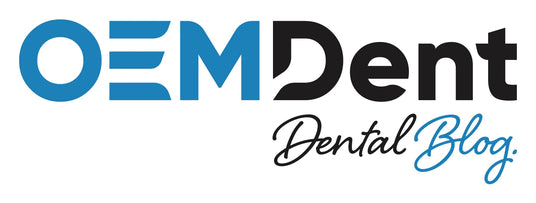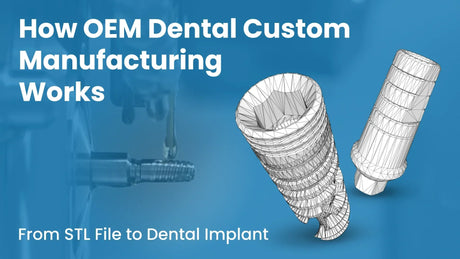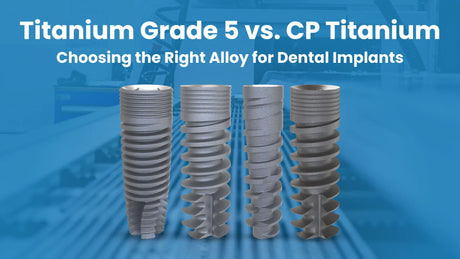

From CAD Design to Clinical Reality: The Role of STL Files in Modern Implant Production
The dental industry has entered a digital era where precision and customization define success. Traditional workflows that relied on physical impressions and manual adjustments are rapidly being replaced by digital models and computer-aided design. At the center of this transformation are STL files, the digital blueprints that bridge the gap between design and manufacturing.
For dental laboratories, clinics, and distributors, understanding how STL files fit into modern implant production is key to improving efficiency, quality, and consistency. At OEM Dent, STL-based workflows are a core part of how custom components and implants are designed, produced, and delivered to professionals around the world.
What Are STL Files and Why They Matter
An STL file (stereolithography file) is a 3D model that digitally represents the surface geometry of an object. In dentistry, this file format is widely used for scanning, designing, and fabricating dental components.
When a dentist or lab scans a patient’s mouth or a custom design, the resulting STL file becomes a precise digital replica of the clinical situation. This file allows for highly accurate modeling of implants, abutments, and prosthetics, down to fractions of a millimeter.
The advantages of using STL files include:
- Accuracy: Enables exact replication of patient anatomy and implant geometry.
- Speed: Reduces manual work, saving time during design and production.
- Consistency: Every part can be reproduced identically when needed.
- Collaboration: Files can be easily shared between clinics, labs, and manufacturers.
From Digital Blueprint to Precision Manufacturing
Once an STL file is received, OEM Dent’s engineering team processes it using advanced CAD/CAM software. The design is refined, analyzed, and prepared for production based on the customer’s specifications.
Each STL-based project follows a systematic workflow:
- File submission: The client sends the STL file, drawing, or detailed product specifications.
- Design verification: OEM Dent engineers review the file to ensure it meets production standards and clinical functionality.
- Prototype modeling: The design is converted into a 3D model suitable for manufacturing.
- Machining process: The component is milled or produced using CNC equipment with micron-level precision.
- Surface treatment and finishing: Depending on the product type, surface treatments such as SLA or RBM are applied to optimize osseointegration and biocompatibility.
- Quality control: Every item undergoes multiple inspections for dimensional accuracy, surface finish, and connection integrity.
This digital-to-physical workflow allows OEM Dent to deliver components that fit perfectly the first time, reducing chairside adjustments and improving clinical outcomes.
Custom Manufacturing Made Simple
STL-based design is not just for complex cases, it has become the new standard for custom implant and abutment manufacturing.
OEM Dent’s process supports a wide range of custom requests:
- Implants and abutments designed to match specific platform connections
- Prosthetic components tailored to individual patient anatomy
- Surgical tools customized for precise implant placement
Clients can send a file for a full component or a single part, and OEM Dent can bring it from concept to finished product within two to three weeks. This rapid turnaround time allows distributors and labs to serve their clients more efficiently while maintaining strict quality and traceability standards.
Material Selection and Manufacturing Precision
Every STL-based product at OEM Dent is created using Titanium Grade 5 (Ti-6Al-4V ELI) for implants and prosthetics, or medical-grade stainless steel for tools. These materials are chosen for their strength, corrosion resistance, and long-term clinical reliability.
For color-coded or esthetic applications, titanium anodizing can also be applied on request. Each product is produced in ISO 7 Class 10,000 cleanroom conditions, ensuring sterility and compliance with international manufacturing standards.
STL Files and the Digital Workflow Revolution
The integration of STL technology into daily dental workflows is revolutionizing how clinics and labs collaborate. Instead of relying on physical impressions or manual measurements, professionals can exchange digital files in seconds, reducing the potential for error.
This digital collaboration also enables:
- Faster case approvals and shorter production cycles
- Simplified communication between technicians and clinicians
- Better visualization of the final restoration before production
- Seamless integration with CAD/CAM milling, 3D printing, and CNC systems
As dentistry continues to evolve, STL file use will become as standard as radiographs or intraoral scans, ensuring smoother communication and higher precision throughout the restorative process.
The OEM Dent Advantage
What makes OEM Dent different is the ability to translate STL data into high-quality, production-ready componentsquickly and efficiently. Unlike generic manufacturers, OEM Dent provides full support throughout the process, from initial design review to packaging and delivery.
For distributors and labs, this means they can confidently offer fully customized, branded components without investing in manufacturing infrastructure. Combined with private label and OEM services, STL-based production gives dental businesses a clear path to growth and innovation.
Final Takeaway
In modern dentistry, the STL file is more than just a design format, it’s the foundation of precision manufacturing. It transforms ideas into clinical reality with unmatched speed and accuracy.
By integrating STL-based workflows, OEM Dent empowers clinics, labs, and distributors to offer personalized solutions, reduce production time, and maintain consistent quality.
To learn more about how STL technology powers OEM Dent’s custom implant manufacturing, visit OEM Dent’s OEM Service page and explore how digital design becomes tangible precision.
References
- Dawood A, Marti Marti B, Sauret-Jackson V, Darwood A. 3D printing in dentistry. Br Dent J. 2015;219(11):521–529. doi:10.1038/sj.bdj.2015.914
- Traini T, Mangano C, Sammons R, Mangano F, Macchi A, Piattelli A. Direct laser metal sintering as a new approach to fabrication of an implant-supported prosthesis. Dent Mater. 2008;24(11):1525–1533. doi:10.1016/j.dental.2008.03.029
- Revilla-León M, Özcan M. Additive manufacturing technologies used for processing polymers: current status and potential application in prosthetic dentistry. J Prosthodont. 2019;28(2):146–158. doi:10.1111/jopr.12734

OEMDent.com offers uncompromised quality, cost-effective dental implants & prosthetics compatible with leading implant systems. We go beyond manufacturing, offering OEM & Private Label services to meet your dental needs.






